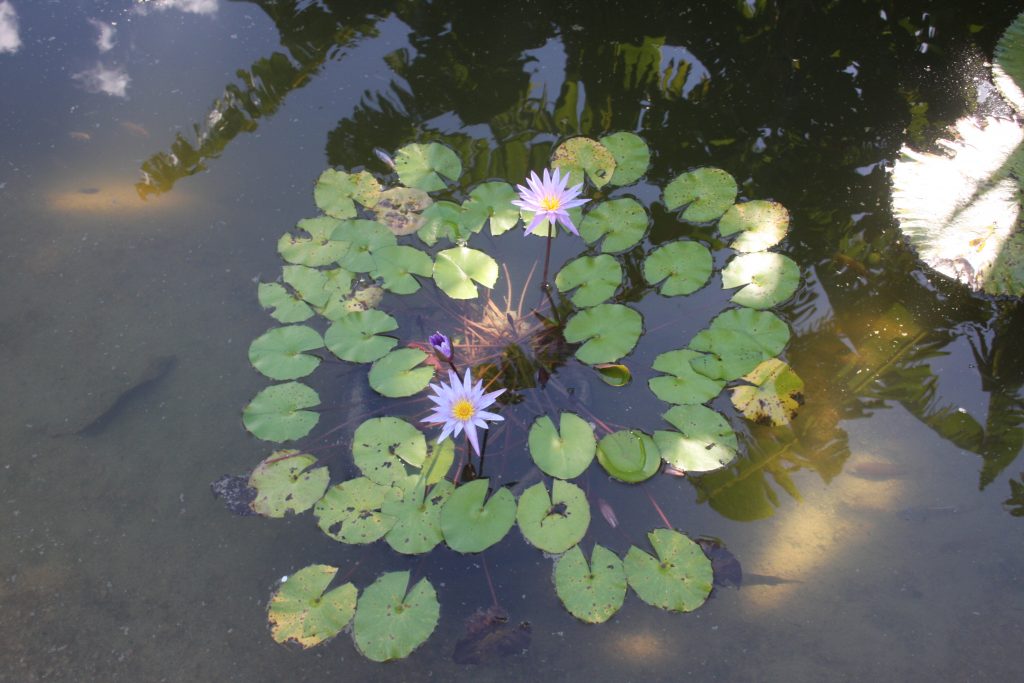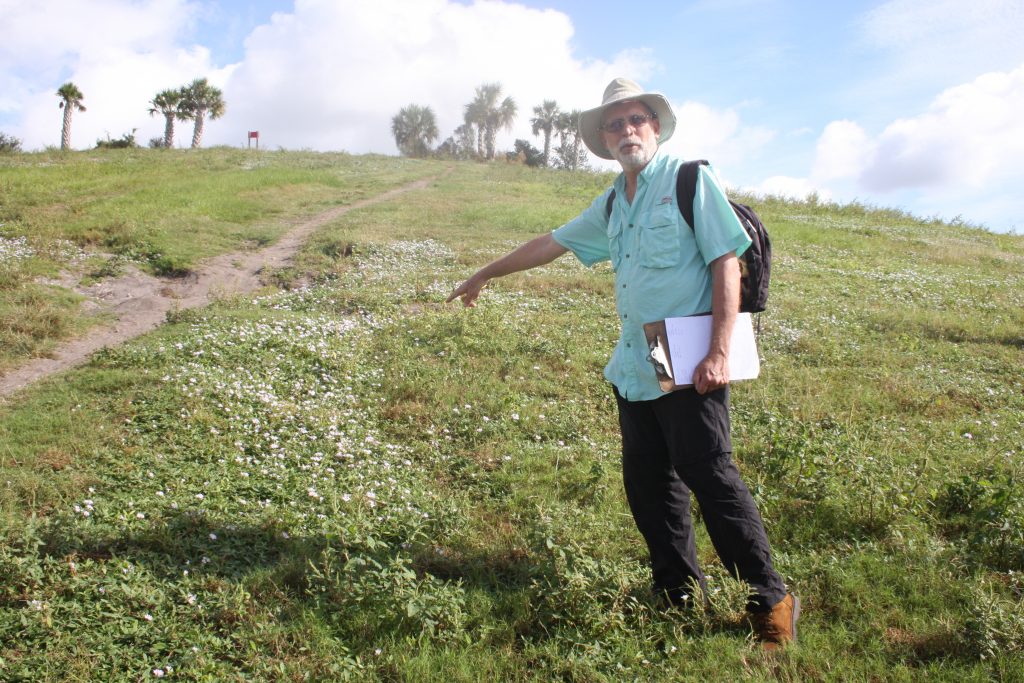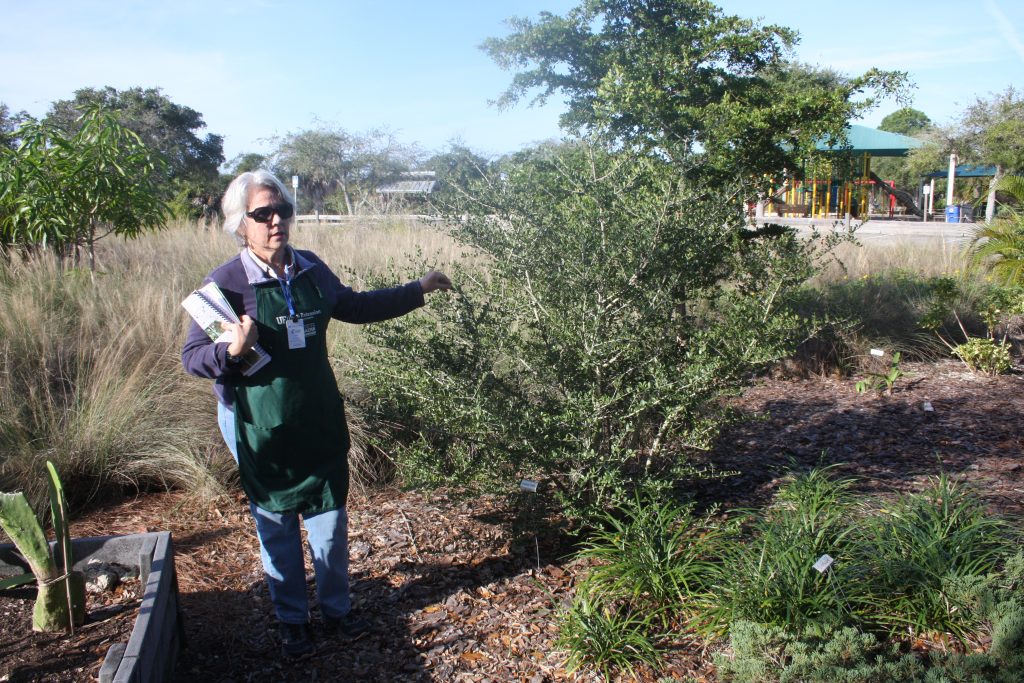Demonstration gardens are inspiring places to visit – there are so many ways to garden in this vibrant, quirky place called Florida.
The gates to public gardens are closed for now … but they will open again.
Here is a modified excerpt from Chapter 6 A Gathering of Demonstration Gardens part of an upcoming book called The Zen of Florida Gardening due out the fall of 2020 if the launch date is possible in these uncertain times.
Enjoy reading the chapter and add these demonstration gardens to your Futures list.
You do have a Futures list right?
Fruit & Spice Park, Homestead
Promises matter.
In 1936 Mary Calkins Heinlein promised to campaign for Preston B. Bird as county commissioner if Bird, when elected, would push for establishing a tropical fruit park. He won.
It took eight years but in 1944 the promise was fulfilled. Redland Fruit and Spice Park opened, a 37-acre oasis with winding paths going past an encyclopedia of tropical and subtropical fruits, vegetables, spices, herbs, nuts and trees along with water gardens where water lilies bloom in abundance. It is part of the Miami-Dade Parks and Open Spaces system.
Mary Heinlein was the first superintendent. She stayed until she retired in 1959. Heinlein planted many of the trees from her own nursery. Mango trees, jackfruit, bananas, a baobab, Asian palms, bamboos, avocados, even a sausage tree. In fact, so many trees that almost every picnic bench scattered around the park has shade.

In 1980 the park was renamed the Preston B. Bird and Mary Calkins Heinlein Fruit and Spice Park. There is no place quite like it anywhere in Florida. At the park store entrance is a tray with cut up tropical fruit for you to sample. As you walk around the park, if you see fallen fruit on the ground and know it is edible, you may eat that fruit but not take it with you out of the park.
My first visit coincided with mango madness. It happens when mangos ripen and fall to the ground. So many mangos, so many iguanas and other lizards eating dropped fruit, mango juice dripping from their jaws. Pretty graphic.
I always find myself gravitating to the water gardens and the sound of falling water. Water lilies are in bloom. I am inspired to replicate what’s happening back home.

Picnic tables are strategically placed under shade trees near the water gardens. I find myself sitting quietly – no hurry, no worry and no road noises, a perfect place for decompressing and dreaming of future garden projects.
The Fruit and Spice Park is currently closed during the corona virus quarantine.
The park is located at 24801 S.W. 187th Avenue, Homestead, Fl. When open again, the hours are 9 a.m. to 5 p.m. daily except Thanksgiving and Christmas. Admission: $10 adult, $3 children ages 6-11, under the age of 6 admitted free. Double check to make sure they are open when you want to go. Bad weather events (read hurricanes) may cause temporary closing. Be sure to pick up a free walking guide. It is very helpful.
Guided tours at 11 a.m., 1:30 p.m. and 3 p.m. all are weather permitting. A lot of walking here so dress accordingly with standard Florida outdoor gear – walking shoes, hat, sunglasses, sunscreen. It can be hot and humid in summer months. There is a tram, though on my visits I’ve never seen it running.
Sarasota Audubon Nature Center, Gardens and Celery Fields
The Audubon Nature Center sits at the base of the mountain, well actually a former landfill now covered with grass and trees, right in the heart of the 400-acre restored wetlands called Celery Fields, once a thriving agricultural area for celery farmers. The Center attracts birders; here for the increasingly famous birding opportunities along with tourists, school children and locals who want to up their bringing wildlife to the garden game.
Address: 999 Center Road, Sarasota. Hours: 9 a.m. to 1 p.m. from October 1 through May 31. Check current hours.
The Celery Fields are open for walkers, runners, birders and bicyclists from dawn to dusk. At the Audubon Center, you can wander through butterfly gardens planted with a focus on what works locally. The gardens are also open dawn to dusk.
Both the Center and the Celery Fields are free. In these stay at home times, it is still possible to walk in the Celery Fields but the Audubon Center is closed.
Some months ago, leading a group of butterfly enthusiasts, including me, butterfly expert Marc Minno from Gainesville stands in the grass beyond the butterfly gardens located behind the Sarasota Audubon Nature Center.
Many in the group are bedecked with binoculars around their necks, cameras dangling off shoulders, notepads sticking out of pockets, sturdy walking shoes and expedition style hats. All lean in closer to listen.
Minno speaks in a casual, low-keyed voice belying the fact that the Gainesville resident is one of Florida’s top butterfly gardening gurus and author or co-author of 12 butterfly books and counting.
Minno points to small white flowers on plants sprouting up out of the grass. “Spanish Needles are one of the top nectar plants for butterflies, also a host plant for Dainty Sulfurs.”
Ah, and I know for a fact my neighbors think Spanish needles are weeds. Wish they could hear this.
Then he reaches down to pick a small piece of ground cover called creeping indigo that attracts the small Ceranus Blue butterfly. Ground cover is good. In fact there are some butterflies and moths that even like Bermuda grass. Who knew?
“Butterflies would love to have some ground cover,” Minno notes.

Then he laughs. “Here we are standing outside the beautiful Audubon butterfly garden and we’ve already found butterflies in the ground cover.”
He heads for the butterfly garden path and we all dutifully follow single file. This garden, like the Audubon center, is just two years old. It is full of plants and bushes that attract bees, birds and butterflies. A White Peacock butterfly sits wings open, waiting for its photo close up while a Cloudless Sulphur flutters on by, oblivious to our presence. Cameras click.
Minno tells us there are 170 different kinds of butterflies in Florida along with over 3,000 kinds of moths. The plants that attract butterflies can also attract moths.
He points out so many attractors – beautyberry for the birds, Yopon holly, sienna plants, sunflowers that attracts different kinds of bees and of course are colorful,
“Your garden is an experiment,” Minno says. “When you see something that works in another garden and plant it in yours it may or may not work – depends on a mixture of things like sun and shade.”
Bottom line:
“Diversity is good,” says Minno.
Walking around the big Audubon butterfly garden is all very beautiful but can be rather daunting.
So much knowledge needed, so much space needed and yes, time is needed, lots of time for tending. I ask Minno if he has advice for those who want to get started in butterfly gardening without having grand garden plans or budget.
“You just need four of five plants and you are good to go,” Minno says. He waves his hand towards a nearby garden box planted with fennel and parsley.
“Plant some fennel and parsley. Oh, and be sure have some blue passion vine and milkweed. All of this can be in containers.”
After making the garden rounds, the group heads up the steep Celery Fields hill. As a result of their 45-minute walk they spot 18 different kinds of butterflies.
Butterflies may have another hatching through November then disappear during “winter” in Florida, the cooler months until April. Then they’ll be back. Be ready! Plant nectar and host plants plus native ground cover. Diversity is good. Pollinators thank you in advance.
Shamrock Park and Nature Center, Venice
The first Thursday of every month from 9 a.m. to 11 a.m. Shamrock Park and Nature Center puts on a guided tour of their demonstration garden (check current events, may be canceled). The free tour ambles through a small but vibrant demonstration garden loaded with ground cover, flowers, bushes and trees. Suggestion: wear a hat and closed toed shoes. Bring a notepad and a camera.
Shamrock Park & Nature Center address: 3900 Shamrock Drive, Venice. The park is currently open for walkers and birders. The Nature Center is closed.
Whether you are a seasoned Floridian seeking to go a little more native in your yard, a visitor curious about Florida plants or a newcomer still in shock that Florida gardening is a whole new game, taking this tour is worthwhile.
“When we moved down to Florida from up north it was a 180 degree difference,” said Lisa Radomsky, a Florida Master Gardener volunteer leading one of the tours. “I’ve learned new things – what is Florida friendly. It doesn’t mean all plants are native, it means choosing plants that are water tolerant and having the right plant for the right area.”

Radomsky holds up a wire-bound book entitled The Florida Friendly Landscaping® Guide to Plant Selection & Landscape Design. This is the bible book for converts to Florida-friendly landscapes. It is free. Everyone gets a copy.
Florida-Friendly landscapes work with Florida’s natural resources by conserving water, creating wildlife habitat, reducing pollution and preventing erosion.
This book is a visual delight. The extensive plant list covers trees, shrubs, vines, grasses, groundcovers, palms, ferns and annuals. Each example has a photograph, a description, pictograms about light and shade, if attractive to birds and butterflies, watering, zones and growth.
Typical house configurations such as a fence line have sample planting illustrations including the sun direction – so much inspiration and must have data. Implement these ideas and you will reduce water, fertilizer and pesticide use. All good.
To go high tech, see the online Florida-Friendly Landscaping® Plant guide at: ffl.ifas.ufl.edu/plants
This is an awesome read right now. For instance, instead of fretting about closed restaurants, dream a whole new Florida friendly garden – a perfect stay at home project.
©2020 Lucy Tobias. Photographs by Lucy Tobias
P.S. Don’t forget – The Zen of Florida Gardens is now taking pre-orders. Great garden adventures await.